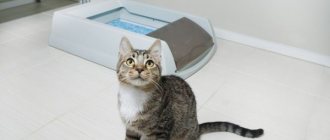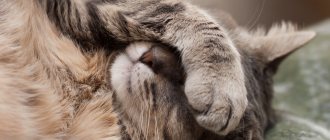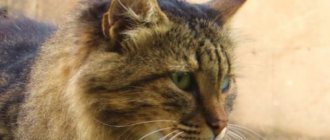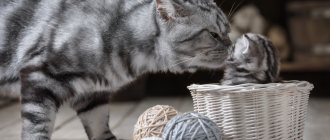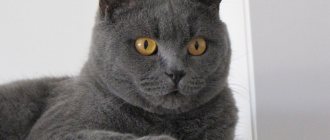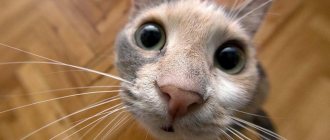Veterinarians very often hear that a cat hunches its back when walking. Of course, at first glance, the symptom should not cause concern for the health of the pet, but the matter is not always limited to this fact. Often cats begin to behave strangely, stop cuddling as before, and at the same time do not allow themselves to be stroked, hissing, scratching. In some cases, behavior becomes inactive and very lethargic. The pet loses the ability to jump onto the sofa; instead, it has difficulty climbing with the help of its claws. All of the above signs are an alarm signal that indicates problems within the animal’s body. For a speedy recovery, it is necessary to conduct an examination, do an ultrasound, and take tests as early as possible. After receiving the research data, the veterinarian will be able to make the correct diagnosis and prescribe adequate treatment.
The main reasons for a hunched cat
If a cat hunches its back when walking, the cause may be various factors, including:
- Spinal injury. One of the most severe and dangerous conditions for a cat is damage to the spinal column. As you know, the spine plays an important role when an animal moves, performs tricks, jumps, and runs. When this department becomes ill, the pet begins to behave strangely. First, the gait changes and activity is lost. Over time, disorders in the vertebrae lead to the development of concomitant diseases. The condition can lead to serious consequences and even death. Therefore, first of all, you should palpate at home along the entire spine, including the upper parts of the tail. A noticeable response to pressure may indicate the location of the injury. To make an accurate diagnosis, it is necessary to take an x-ray of the entire column. If the injury is minor, the doctor prescribes a complex of vitamins and sedatives for calm behavior. In severe situations, surgical treatment is recommended;
- Rickets. The disease often develops due to poor nutrition. Balance in nutrients must be maintained throughout life. If there is a malnutrition, a lack of vitamins and minerals, problems develop in all parts of the body, including the spine. Veterinarians often diagnose calcium deficiency. To restore health, it is necessary to urgently adjust the animal’s diet, as well as introduce vitamin supplements. In severe cases, systematic treatment with a whole range of drugs is required;
- Character. A cat does not always hump its back when walking due to some disease. There are situations when a pet simply shows its character in this way. It might just be a bad habit. As a rule, when visiting a doctor, cats do not show such symptoms; they do not have problems with their internal organs. To correct the situation, it is recommended to take a course of sedatives. Perhaps the arching of the back is associated with nervous disorders;
- Stress or fear. Cats arch their backs due to fear and dissatisfaction, as well as in stressful situations. They arise for many reasons. This may be a long absence of owners from home. When a pet is left in the care of strangers in an alien environment, then after the owners arrive, the cats continue to arch their backs and show signs of aggression.
What is ataxia?
Without going into details, this is the name for a set of symptoms that imply problems with coordination of movements and body position in space. There are three types of this pathology:
- Cerebellar ataxia in cats is caused by damage to the cerebellum.
- Accordingly, vestibular occurs in cases where something is very wrong with the vestibular apparatus located in the inner ear.
- Sensitive . In some ways it is similar to the cerebellar, only in this case important nerve cords are damaged.
There are different causes of ataxia in cats. Most often, the development of the disease is due to:
- Poisoning with various poisons.
- Hereditary diseases accompanied by degenerative phenomena in the nervous tissue.
- Injuries that occur especially often in March, when loving cats fall from balconies.
- Lack of vitamin B1. This is generally typical for cats: many owners “pamper” them with fresh river fish, which contains the enzyme thiaminase. It destroys thiamine, that is, B1, resulting in ataxia. This is especially noticeable in kittens.
- If the cat is “hooked” on some plants. For example, a large dose of catnip can send a cat into “nirvana” for several minutes. At this time, the pet looks like an inveterate drunkard.
- Traumatic brain injury.
- Tumor.
- Infection. In particular, feline panleukopenia is very dangerous.
- Hydrocephalus or cerebral edema.
Associated symptoms
A cat humps when walking for various reasons, and each of them is manifested by a number of associated symptoms:
- lethargic behavior;
- refusal of food and water;
- inability to jump onto a chair;
- hissing, scratching;
- stools that are too hard;
- the cat began to sleep only on its back;
- walks with his tail down.
All of the above symptoms may indicate problems with the digestive system. Perhaps the reason lies in increased stomach acidity. As a result of this pathology, all the fluid in the body is absorbed by the stomach. As a result, the stool clumps into a solid mass. The animal begins to experience colic and intestinal pain. To alleviate the condition, the pet arches its back. The doctor can clarify the diagnosis after palpation of the abdomen.
Proestrus
The onset of estrus, or its first stage, lasts 1-2 days and can be noticed by the owner by the cat's more restless behavior. The most subtle indicator of this stage is the cat. You may notice that the cat has a slightly enlarged and moist vulva. Increased appetite and restlessness are also noted. She makes low, guttural cries and fawns on her owner more than usual. She is attractive to cats, but does not yet allow them to approach her. Proestrus is characterized by a period of courtship, during which the very presence of a cat nearby stimulates the activation of hormone secretions in the cat, which leads her to a real estrus.
- Signs of estrus in cats
- Signs of estrus in cats
Treatment methods
Treatment directly depends on the cause of the disease. If problems with the spine are due to rickets, then calcium supplements are prescribed. In case of stagnation in the intestines, a complex of medications is prescribed to improve the functioning of the digestive system. Almagel, Omez, Vetom are prescribed. In severe cases, the hormonal drug Metronidazole may be indicated. Sinulox and Baralgin are recommended as injections. It is very important to get tested for biochemistry. Hepatovet is given to support the liver.
A correct diagnosis will allow you to prescribe adequate treatment and allow your cat to recover quickly.
Estrus
The second stage of the estrous cycle is estrus, or estrus itself, the stage of sexual receptivity. Breeders talk about it as a calling cry to a cat, or a hunt. It can last from one to twenty-one days, with an average duration of 5-7 days. The most favorable days for coverage are the 3rd and 5th days. Although this factor is very individual for each cat (some of them do not ovulate until the 9-10th day). Depending on the cat's temperament (most often determined by its breed), it demonstrates its condition in different ways. One cat becomes “noisy”, constantly meowing loudly; the other, presenting a pitiful sight, lies spread out - suffers in silence, only occasionally “quacking”, evoking universal sympathy with her unhappy appearance.
Cat, March, heat
But both of them become more intrusive and affectionate, rubbing against objects and clearly staring at all male representatives (cat, owner, guest). They roll around on the floor, and if you stroke the lumbosacral region of a cat with your hand, a contraction of the perianal region may occur, the cat falls on its front paws and, as it were, “tramples” with its hind paws, moves its tail to the side and rolls around on the floor. The animal's appetite is reduced or absent. There is frequent urination.
At the peak of estrus, the cat often screams as if it is suffering from unbearable pain, this is the call that worries all the cats in the area.
To determine if your cat is ready to be coated, gently hold her and run your hand along her back, from her neck to her tail. If yes, then she will raise her pelvis up, move her tail to the side and begin to stomp on one place with her hind legs. There is also a so-called “erased” estrus, which passes with invisible or muted signs. The same estrus that makes ordinary cat owners very happy and greatly upsets breeders planning to have purebred kittens.
Signs of estrus in cats- Signs of estrus in cats
Why do cats sleep a lot?
This is genetically embedded in them. The distant ancestors of cats slept all day so that by evening they would have enough energy for intense hunting. This was especially important during the cold season, when food was more difficult to find and more energy was required to maintain body temperature. This is not true for domestic cats, but they still sleep longer in cold or rainy weather. There is another reason that wild animals did not have. This is boredom. When a cat is alone at home and has nothing to do, she can pass the time by falling into a sweet sleep. However, when a cat appears to be sleeping, it is not always that she is actually fast asleep. She can simply doze and be ready to take active action at any second. However, even if you provide your cat with an interesting activity, she will not be cheerful and active all day. It is normal for her to sleep 13-16 hours a day, and disruption of sleep patterns will lead to illness.
External factors and emotions
Cats use their tail quite freely. A free position, when the tail is lowered to the ground with a slightly curved tip, is the norm for an animal at rest. However, tucking the tail, holding it close to the belly, or not raising the tail during the day are clear violations.
Note! Cats tend to sleep with their tail between their legs, as this position is considered the safest.
Aggression – before attacking or feeling the need to defend themselves, cats tuck their tails or lash their sides with it. This is a natural reaction as the animal protects itself with its tail, covering its belly. By whipping itself on the sides, the pet encourages itself, in other words, it gathers its strength and thoughts.
Impact of external factors, emotions
At rest, the pet's tail lowers to the ground and the tip bends slightly. An alarm signal that should alert owners is that a pet tucks its tail to its stomach during the day and shows anxiety. Among the reasons that cause this manifestation, veterinarians identify:
- Prolonged stress. A pet that spends a long time on the street without the supervision of its owners can get a nervous shock, which will end quite predictably - the cat tucks its tail and hides in a secluded corner. In such cases, you will have to apply maximum attention and affection to help the cat cope with stress.
- Beatings, lack of attention from owners. Humiliation and frequent bullying of a pet can cause constant fear of the pet, which tries to become less noticeable and not attract the attention of the offender.
- Kitten protection. A cat trying to protect its offspring shows anxiety - it alternates between tucking its tail, waving in different directions, and patting itself on the sides.
Often, an alarming sign appears even while playing with a pet - the owners involuntarily cause pain to the cat. In such cases, you should not continue - it is recommended to leave the room and leave the animal alone. After some time, return and make sure that everything is fine - the cat has forgotten about the offense and will continue to frolic with pleasure with the owner.
Diagnostics
Often, to a professional veterinarian, ataxia is obvious upon initial examination. But to fully understand the situation, it is necessary to collect all the anamnesis data. Have there been any injuries (even several years ago), how and what does the cat eat, what severe infections has it suffered? If possible, how her mother’s pregnancy progressed. Examination of the ears with an otoscope is mandatory.
X-rays, ultrasound, or even an MRI will be needed to confirm the diagnosis and identify or rule out tumors, hemorrhage, or swelling of the brain. In some cases, if a brain or spinal cord infection is suspected, a cerebrospinal fluid test may be necessary.
Physiological reasons
This manifestation is possible in a number of diseases and health problems, we list the main ones:
When a dog is hunched over on top of everything else, this may be a signal of spinal deformation. Most often, such symptoms appear when 2-3 vertebrae rotate. This health problem is detected even in puppyhood and you definitely need to pay attention to it. If the nerves between the vertebrae are pinched, the tail becomes immobile. Quite often, with this defect, there is a hunching of the back, it is difficult for the animal to sit down, and movements are impaired.
In some cases, when a dog shakes and tucks its tail, these are symptoms of hypoglycemia. This condition is caused by a sudden drop in blood sugar levels. For certain breeds of animals, a tucked tail is considered the norm, for example, for a greyhound, and German shepherds with a downward tail are considered purebred and purebred.
When a dog is trembling, lethargic and has its tail between its legs, you should pay attention to the general condition of the animal. Assess appetite, body temperature, whether the dog touches water, and whether it can stand up on its own. Such manifestations can indicate a variety of diseases, these are:
- poisoning;
- toothache;
- diseases of the gastrointestinal tract;
- diseases of the circulatory system.
As you can see, an animal can behave in a similar way with a variety of diseases. What should the owner do in such a situation, how to help his four-legged friend?
Why cats hate bathing
Cats don't like the feeling of wet fur. Usually its top layer somehow repels water, but after swimming it becomes completely wet. This makes cats feel heavy and clumsy, rather than agile and graceful. In addition, wet wool does not allow them to maintain a high body temperature, so after washing they are still cold for a long time. Adding to the unpleasant emotions is the fact that the owner does not ask whether the cat wants to bathe or not. He just takes her and washes her, while she wants to decide what to do and what not to do. She also prefers to always be able to change her mind and leave.
Problem with nerve endings
During the period of active growth, cats sometimes experience disturbances in the development of the spine. This leads to pinched nerve endings and increased muscle tone. Then the animal cannot fully control its tail, and is not even able to lift it.
It happens that disorders affect the entire musculoskeletal system. Such pets experience underdevelopment of the chest or curvature of the paws. A nerve rupture may also occur due to injury: for example, a strong blow to the back.

